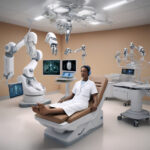Mind over machine: Neuralink’s breakthrough lets patient control robot with thoughts
Neuralink has claimed to have achieved a new milestone in brain-computer interface technology, with an incredible breakthrough that allows a patient to control a robot using only their thoughts. This revolutionary achievement marks a significant step forward in the field of neurotechnology and has the potential to transform the lives of individuals with physical disabilities.
Founded by tech entrepreneur Elon Musk, Neuralink has been at the forefront of developing cutting-edge brain-machine interface technology. The company’s latest breakthrough involves implanting small, flexible threads into the brain that are capable of monitoring neural activity. By decoding these neural signals, Neuralink’s technology enables individuals to control electronic devices, such as computers or robots, using their thoughts alone.
The implications of this breakthrough are profound. For individuals with paralysis or other mobility impairments, the ability to control a robotic device using their thoughts could offer newfound independence and freedom. Tasks that were once impossible may now become achievable, thanks to the power of neural technology.
One of the key advantages of Neuralink’s approach is the high level of precision and accuracy it offers. By directly interfacing with the brain’s neural activity, rather than relying on external sensors or cumbersome equipment, Neuralink’s technology provides a more seamless and intuitive user experience. This level of precision is essential for tasks that require fine motor control, such as typing on a keyboard or manipulating objects with a robotic arm.
In addition to its applications for individuals with physical disabilities, Neuralink’s technology also holds promise for enhancing human capabilities beyond their natural limits. By connecting the human brain to artificial intelligence systems, individuals could potentially access vast amounts of information or communicate with others in entirely new ways. The possibilities for enhancing cognitive abilities or even experiencing virtual realities directly through the brain are truly groundbreaking.
Of course, with any new technology that involves interfacing with the human brain, ethical considerations come into play. Neuralink’s approach raises important questions about privacy, security, and the potential for misuse. As the technology continues to advance, it will be crucial to establish clear guidelines and regulations to ensure that it is used responsibly and ethically.
Despite these challenges, the potential benefits of Neuralink’s breakthrough are undeniable. By harnessing the power of the human brain to control machines with a mere thought, Neuralink is opening up a world of possibilities for individuals with disabilities and pushing the boundaries of what is possible for the human mind.
As Neuralink continues to refine its technology and explore new applications, the future of brain-machine interfaces looks increasingly promising. With each new breakthrough, we come one step closer to a world where the line between mind and machine blurs, and the extraordinary capabilities of the human brain are fully unleashed.
Neuralink’s groundbreaking achievement in allowing a patient to control a robot with their thoughts represents a major leap forward in the field of neurotechnology. As we look ahead to the possibilities that this technology unlocks, one thing is clear: the power of the human mind knows no bounds.
Neuralink, brain-computer interface, neurotechnology, artificial intelligence, human capabilities












